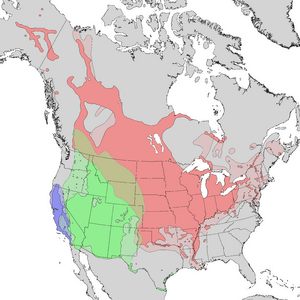Sandbar willow facts for kids
Quick facts for kids Sandbar willow |
|
|---|---|
 |
|
| Leaves and staminate flower | |
| Scientific classification | |
| Genus: |
Salix
|
| Species: |
exigua
|
 |
|
| Natural range of Salix exigua S.e.exigua: green, S.e.hindsiana: blue, S.e.interior: red |
|
The sandbar willow (scientific name: Salix exigua) is a type of willow plant. It is also known as the narrowleaf willow or coyote willow. This plant grows naturally across most of North America. You can find it from Alaska in the north, all the way east to New Brunswick in Canada. It also grows south into northern Mexico.
In some places, the sandbar willow is quite rare. For example, it is considered a threatened species in Massachusetts. It is even more rare in Connecticut, Maryland, and New Hampshire, where it is listed as endangered.
Contents
What Does the Sandbar Willow Look Like?
The sandbar willow is a deciduous shrub. This means it is a woody plant that loses its leaves every autumn. It can grow to be about 4 to 7 meters (13 to 23 feet) tall.
This willow spreads by sending out new shoots from its base. This helps it form thick groups of plants that are all connected, like a big family. These groups are called clonal colonies.
Leaves and Flowers
The leaves of the sandbar willow are long and thin, shaped like a narrow spear. They are usually 4 to 12 centimeters (1.5 to 4.7 inches) long. They are also very narrow, only about 2 to 10 millimeters (0.08 to 0.4 inches) wide. The leaves are green, but they can also look grayish. When they are young, they often have soft, silky white hairs. The edges of the leaves are mostly smooth, but they might have a few small, widely spaced teeth.
The flowers of the sandbar willow grow in structures called catkins. These appear in late spring, after the leaves have already come out. This plant is dioecious. This means that male and female flowers grow on separate plants. The male catkins can be up to 10 centimeters (4 inches) long. The female catkins can grow up to 8 centimeters (3 inches) long.
Seeds and Fruit
After the flowers, the plant produces fruit. The fruit looks like a cluster of small cases called capsules. Each capsule holds many tiny seeds. These seeds are covered in shiny white, silky hairs. This silk helps the seeds float away in the wind.
Different Types of Sandbar Willow
There are two main types, or subspecies, of the sandbar willow. These two types meet in the western part of the Great Plains in North America.
- S. exigua subsp. exigua: This type is found in western North America. Its leaves stay grayish all summer. They keep their silky hairs. The seed capsules are usually 3 to 6 millimeters (0.12 to 0.24 inches) long.
- S. exigua subsp. interior: This type grows in eastern and central North America. Its leaves usually lose their hairs and turn green by summer. They only rarely stay hairy. The seed capsules are a bit longer, about 5 to 8 millimeters (0.2 to 0.3 inches) long.
Growing Sandbar Willows
The sandbar willow is sometimes grown as an ornamental plant. This means people plant it in their gardens or parks because it looks nice. In the United Kingdom, it has even won an important prize. This prize is called the Royal Horticultural Society’s Award of Garden Merit.
How People Use Sandbar Willows
Long ago, Native Americans used this willow for many things. The flexible branches were used as strong poles and for building materials. Smaller twigs were woven into baskets. The bark was used to make cord and string.
The bark and leaves also had several medicinal uses. For example, the Zuni people would make a special drink from the bark. They used this drink to help with coughs and sore throats.
Animals also use the sandbar willow. Farm animals like cows and sheep eat the leaves. This is called browsing.
Sandbar Willow and Its Ecosystem
The sandbar willow plays an important role in its environment. The male flowers produce pollen, which is a food source for bees. Bees help pollinate the flowers.
This willow is also a host plant for several types of butterflies and moths. This means that the caterpillars of these insects eat the willow's leaves. Some of these insects include:
- The California hairstreak butterfly
- The Lorquin's admiral butterfly
- The mourning cloak butterfly
- The sylvan hairstreak butterfly
- The tiger swallowtail butterfly
See also
 In Spanish: Salix exigua para niños
In Spanish: Salix exigua para niños

